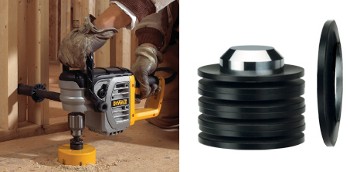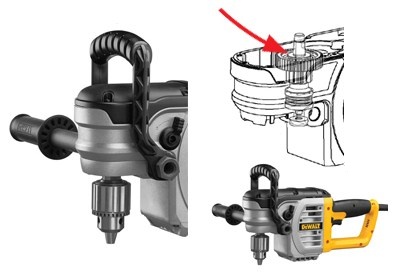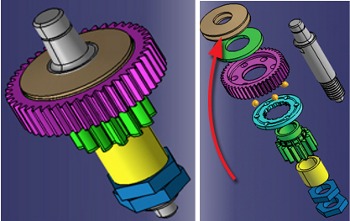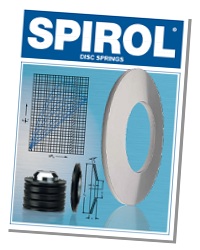 |
| August 27, 2013 | Volume 09 Issue 32 |
Designfax weekly eMagazine
Archives
Partners
Manufacturing Center
Product Spotlight
Modern Applications News
Metalworking Ideas For
Today's Job Shops
Tooling and Production
Strategies for large
metalworking plants
Engineer's Toolbox:
Using disc springs in a heavy-duty right-angle drill

SPIROL disc springs (right) and the DEWALT high-performance industrial drill. [DEWALT product images used with permission by DEWALT Industrial Tool Co.]
DEWALT, a subsidiary of Stanley Black and Decker, is a brand with a reputation for providing high-quality professional power tools, contractor tools, and accessories. DEWALT's lead design engineer for drills was tasked with designing a high-power right-angle drill that was lightweight, compact, and portable. As is common with hand power tools, the goal with the design was to maximize performance while minimizing the size of the tool.
The design would incorporate a mechanical clutch built to limit maximum torque output to 70 ft-lb. Absent the clutch, with the huge gear reduction of 75:1, the drill would be capable of producing a lock rotor torque at the spindle of 175 ft-lb, transmitted directly to the operator of the tool. It was determined early on that the clutching thrust required in the space available could only be achieved by a disc spring design. Compared to conventional coil springs, disc springs offer a higher load capacity in less space. Additionally, longevity and reliability are high measures of quality for professional tools used on a daily basis. The life and performance warranty of the tool was reliant on the disc spring design.
Disc springs are conically shaped, washer-type components designed to be axially loaded. What makes disc springs unique is that based on the standardized calculations of DIN 2092, the deflection for a given load is predictable and the minimum life cycle can be determined. Disc springs can be statically loaded either continuously or intermittently, or dynamically subjected to continuous load cycling. They can be used singly or in multiples, stacked parallel, in series, or in a combination thereof.
The advantages of disc springs compared to other types of springs include the following:
- A wide range of load/deflection characteristics;
- High load capacity with small deflection;
- Space savings -- high load-to-size ratio;
- Consistent performance under design loads;
- Longer fatigue life;
- Inherent dampening, especially with parallel stacking; and
- Flexibility in stack arrangement to meet your application requirements.
Early on in development, DEWALT's engineers were working with a low-cost disc spring supplier. DEWALT had developed and theoretically calculated the initial disc spring design. The first prototype built failed, with the new design achieving less than half the targeted cycle life. Analysis indicated that premature fatigue failure of the disc spring was due to higher-than-expected stress, lesser quality material, and a less-than-ideal manufacturing process by the original supplier.

Location of the mechanical clutch assembly in the DEWALT unit.
Determined to find a solution, the lead engineer on the project contacted SPIROL to discuss the disc spring design. SPIROL's application engineering team evaluated the design objectives/constraints and quickly determined they could not be met by a standard disc spring. SPIROL essentially became an extension to DEWALT's team and focused specifically on the disc spring portion of the design. SPIROL recommended a custom disc spring design that had alternate dimensions, material, and secondary operations. For this demanding and high-performance application, these special features added significant value and ended up costing only pennies more compared to the product offered by the original supplier.
DEWALT tested SPIROL's recommended disc spring, and the tool far exceeded the cycle life requirement. By partnering together, DEWALT and SPIROL determined the best disc spring design for the new angle drill, minimizing costly development time for both companies.

Two disc springs stacked in series in the mechanical clutch assembly.
SPIROL's staff of engineers can review your application needs and work with your design team to recommend the best solution. One way to start the process is to go to "Disc Springs" in SPIROL's Optimal Application Engineering portal.
*Note: SPIROL considers stacking disc springs to be a challenge and encourages design engineers to consult SPIROL's special .pdf resource on "How to stack disc springs."

You can download the complete SPIROL disc springs catalog -- complete with extensive design guide -- by clicking here. For a .pdf of just the abbreviated guidelines at left, click here. Learn about stacking disc springs here.
------------------------------------
Disc spring design guidelines
Sizing and selection
- Select the disc with the largest outside diameter (De). This reduces the stresses at a given force (F)/deflection (s) ratio, and thus enhances fatigue life. An outside (De) to inside diameter (Di) of 1.7 to 2.2 also enhances performance and longevity.
- Select a disc that achieves the maximum force required at less than 75 percent of its deflection. Deflection of 75 percent of cone height (ho) should be the design maximum. Reducing deflection increases fatigue life.
- Force/deflection curves can be changed by varying the cone height (ho) to thickness (t) ratio. Curves for discs may be plotted with the force/deflection data provided on pages 9-14 of the complete SPIROL disc springs catalog (link at right) at 25 percent, 50 percent, 75 percent, and 100 percent of deflection.
- Thicker discs have greater damping (hysteresis) characteristics.
Orientation
- Shorter stacks are more efficient. This is particularly important under dynamic loading. Discs at the moving end of the stack are overdeflected, whereas discs at the opposite end are underdeflected. This results from the friction between the individual discs as well as the discs and the guiding mandrel or sleeve. Use of the largest practical outside diameter discs will reduce the number of individual discs and total stack height. It is recommended that total stack height not exceed three times the external disc diameter (De) or 10 total discs.
- When discs are used in parallel, the following factors should be considered:
1. In dynamic applications, the generation of heat;
2. The relationship between loading and unloading forces due to friction;
3. Hysteresis, the increased damping resulting from friction between the discs; and
4. Lubrication - A must in parallel disc applications. - Lubrication is required for the efficient use and extended life of discs. In moderate applications, a solid lubricant such as molybdenum disulfide will generally suffice. In severe and corrosive applications, an oil or grease lubricant housed in a chamber may be required.
- Hardened thrust washers will alleviate surface damage/indentation when discs are used in conjunction with soft materials.
Fatigue life
- Fatigue life can be improved by increasing preload and reducing maximum deflection. This will likely require additional discs in series, but will extend life.
- Shot peening induces favorable compressive stresses on the disc surface. This reduces the likelihood of fatigue failure due to tensile stresses, which generally start on the surface.
- Presetting is defined as a single or repeated compression of a heat-treated disc to the flat condition. The strains induced give rise to plastic deformation, and the spring thereby loses height. The remaining free conical height (ho) results from the residual stresses being at an equilibrium of forces and moments. The disc will no longer plastically deform during subsequent loading. This allows for higher load stresses and longer fatigue life.
Materials and finishes
- High carbon and alloy steel materials provide excellent strength and endurance life in most applications. The standard coating of zinc phosphate and oil provides adequate protection from humidity and occasional moisture. More effective protective finishes are available, but these tend to wear off in dynamic applications.
- Electroplated finishes should always be avoided. Hydrogen embrittlement poses too great of a risk in highly loaded discs having a hardness over HRC 40.
- Austenitic stainless steel is a very good choice for static and low-cycle applications. It provides high forces and excellent corrosion resistance. This material will continue to work-harden with use, so cycle life is limited, but creep resistance is good.
- For dynamic applications where corrosion protection is required, precipitation hardening stainless steels are recommended. These steels are nearly as strong as the standard DIN materials and very corrosion resistant.
- At temperatures over approximately 200 deg F (100 deg C), standard DIN materials can begin to creep, or take a set. Between 300 deg F and 400 deg F (150 deg C to 200 deg C), the materials lose their strength and are no longer considered viable. Stainless steels are a bit more temperature resistant, but only up to 575 deg F (300 deg C).
Want more information? Go to www.spirol.com.
Source: SPIROL
Published August 2013
Rate this article
View our terms of use and privacy policy
